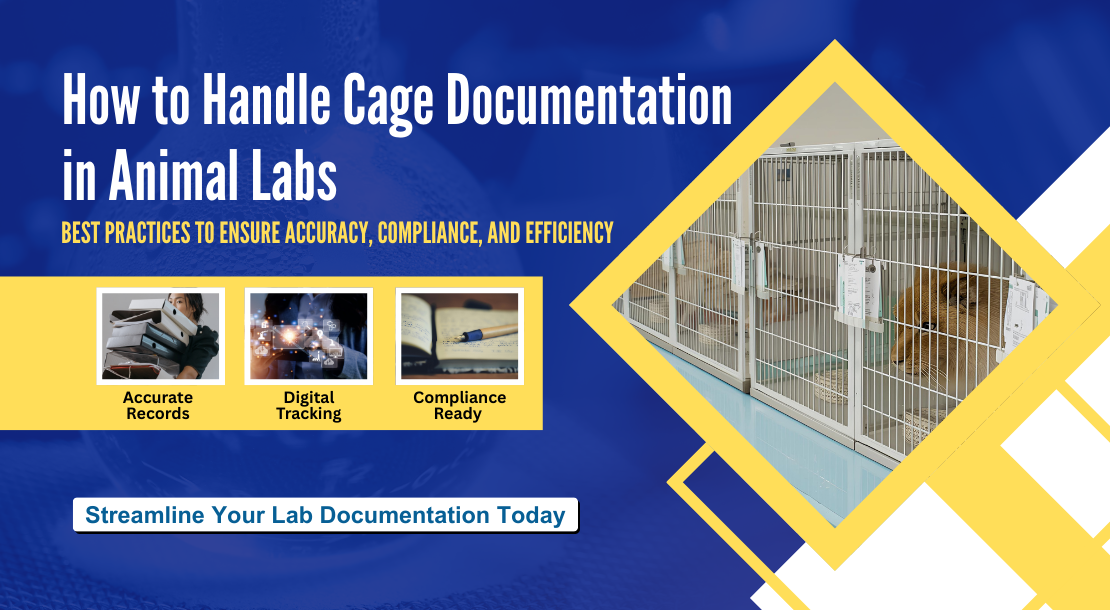
04 Sep How to Handle Cage Documentation in Animal Labs
Lab animal handling demands the greatest level of precision, simplicity, and adherence to
rigorous research protocol. Cage documentation of lab animals is probably the most important
step in the process. Record keeping of animal information to tracking experimental progress,
precise record keeping assures animal care, regulatory compliance, and sound research. New
technologies such as Cage Talkers are transforming the task, allowing labs to abandon pen-
and-paper traditional setups for quick electronic solutions.
Why Cage Documentation Is Important in Animal Laboratories
Cage documentation is not merely labelling cages; it’s the cornerstone of correct animal care
and research. Every cage usually has such information as:
● Animal species, strain, and ID numbers
● Experimental group or project association
● Feeding schedules and special care instructions
● Medical treatments and medical history
● Breeding status and study progress
Correct cage documentation prevents any applicable information from being left out, and
researchers, caretakers, and compliance officials are all on the same page. In compliant
facilities, erroneous or absent data will result in compliance infractions, redundant experiments,
or suboptimal research findings.
Detracts of Old Cage Documentation
The majority of labs used to utilize manually written labels or blank printed cards to record
cages. Though these systems seem easy, they are prone to having shortcomings:
● Human mistake: Handwritten reports may be read or written down inaccurately.
● Constrained space: Prolonged cage cards lack room for extensive data.
● Poor traceability: Cards must frequently be updated, and this causes clutter and loss of
historical data.
● Compliance risks: Incomplete or ambiguous documentation can be insufficient to
satisfy rigorous regulatory requirements.
These cause inefficiencies and threaten to compromise the integrity of scientific work.
The Role of Digital Solutions in Cage Documentation
In meeting these needs, laboratories are increasingly turning to digital systems. Digital systems
not only simplify cage documentation for laboratory animal procedures but also centralize
records for immediate viewing.
An example of such innovation in this regard is Cage Talkers, a digital system that
revolutionizes how information becomes available, current, and disseminated across the laboratory
facilities.
Cage Talkers: A Game-Changer in Cage Documentation
Cage Talkers is an automated display system created solely for laboratory animal facilities of
research animal facilities. Rather than paper cage cards, Cage Talkers connects to laboratory
management software and dispenses electronic real-time data on cage-mounted displays.
Major Advantages of Cage Talkers:
Instant Updates: Researchers can update cage information on their computer or tablet, and the
data is updated instantly on the cage display.
Enhanced Accuracy: With the elimination of the human factor, Cage Talkers maintains
accurate and consistent data.
Compliance Guarantee: Computer records comply with regulatory standards of accuracy.
traceability, and transparency.
Efficiency Dividend: Administration is reduced as staff spend less time working with paper
cards and spend more time on animal care and research activities.
Flexibility: Complete information, ranging from animal ID to project information, can be shown
and updated as required.
By finding the right balance between accuracy and ease, Cage Talkers has become a must-
have for labs that want to improve their documentation process.
Best Practices for Cage Documentation Management in Animal Labs
Regardless of whether a facility operates with legacy systems or has already transitioned to
digital technologies such as Cage Talkers, and some best practices can make documentation
effective:
Standardize Data Entry: Design specific instructions for data entry to prevent inconsistency.
Train Employees Properly: All employees handling animals must know the document
processes.
Use Technology: Implement tools such as health record software and Cage Talkers to limit
errors and enhance processes.
Audit Records Periodically: Conduct periodic checks to ensure all cage data is up-to-date and
accurate.
Maintain Openness: Documents must be readily available for researchers, veterinarians, and
compliance authorities.
The Future of Cage Documentation
With research facilities growing and animal testing becoming more high-tech, digital evolution is
no longer a nicety; it is a necessity. Technology like Cage Talkers is the future of cage usage
documentation in animal lab procedures, where efficiency, compliance, and accuracy are all
accomplished at the same time.
By embracing e-solutions, labs are not merely complying with current practice but also
preparing themselves for lasting success in advancing science responsibly.
Conclusion
Cage record-keeping in laboratory animals demands accuracy, orderliness, and innovative
thinking. Though the old ways have been beneficial, the current technology, like Cage Talkers,
is introducing new standards of efficiency and regulation into the practice. By embracing such
technologies, labs are able to maintain precise records, cut down on human errors, and
streamline day-to-day operations, ultimately impacting better research outcomes and better
animal care.


